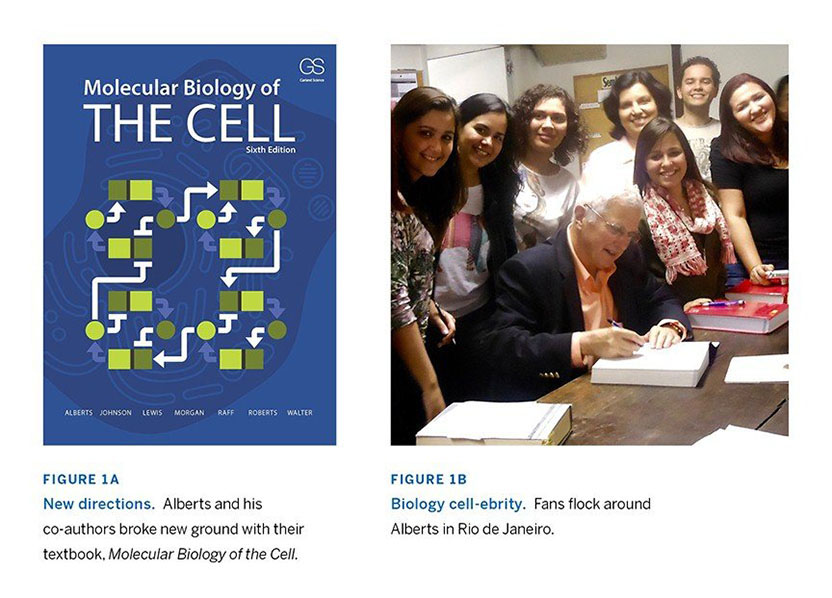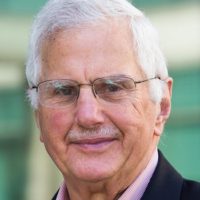As Alberts recovered from the shock and dejection (and conducted the additional experiments required to earn his PhD), he scrutinized his approach to research. For much of graduate school, he had been testing a pet theory. Confirmation would have been exciting, but negative results pointed only toward the conclusion that his idea was wrong.
This self-examination spurred a key decision. In the future, he would strive to design experiments that would yield useful information even if they did not turn out as predicted.
That vow prompted him to invent a technique that proved extremely fruitful. It allowed him to capture and analyze any proteins that adhere specifically to DNA. In 1970, he reported that one of the DNA-binding proteins he identified attaches to individual strands of the double helix and straightens them, thus enabling the enzyme that adds letters to a growing DNA chain to do its job easily. The existence of this so-called single-strand DNA-binding protein was a surprise, but research has since established that similar proteins play central roles in all cells.
Wanting to pin down how DNA is synthesized, he devised a strategy for purifying the proteins that are required to replicate a simple bacterial virus’s DNA. In 1975, he demonstrated that six proteins, together, can synthesize DNA in a manner that closely mimics the way this process occurs inside cells. According to conventional wisdom, each protein would act sequentially, after randomly colliding with the DNA template. In contrast, Alberts found that they come together to form a compact molecular machine whose parts move relative to one another. The constituents perform their distinct biochemical tasks in an ordered fashion, as the power stored in ATP’s renowned high-energy bonds provokes shape changes in the proteins that drive the DNA-copying reaction forward.
Alberts correctly recognized that this type of cellular apparatus would serve as an archetype for many other physiological processes. Today’s students can barely fathom an era when this view was not woven into the thread of molecular biology.
Educating students, preparing citizens
In the late 1970s, Alberts embarked on an ambitious endeavor to unite the historically descriptive field of cell biology with the emerging field of molecular biology in a new textbook. In 1983, he and his co-authors published the first edition of Molecular Biology of the Cell.
In crafting the book, Alberts and the team bridged not only novel subject matter, but also hatched a fresh approach to textbook writing. They wanted their descriptions to enlighten rather than merely summarize. Toward that end, they drafted chapters about their specialties and then swapped with their colleagues who did not know those topics. This unconventional strategy embedded neophytes in the process of shaping explanations, and it produced unprecedented clarity.
Prioritizing conceptual learning, the authors avoided vocabulary lists that tend to overwhelm, distract, and confuse students who don’t yet have a framework for the detailed terminology. Clear, informative images, designed to communicate the relevant message in a few seconds, complement the text.

Alberts’s passion for transforming how students learn science extends well beyond cell biology. In numerous roles, he has campaigned for science education that teaches problem solving rather than memorization of facts. Success in this realm, he argues, would equip people to participate in discussions about many issues that affect society and to think critically as they grapple with life’s daily challenges.
In 1993, Alberts took the helm of the National Academy of Sciences (NAS) and led a charge to transform science education in the US. As president of the organization for 12 years, he fueled the completion of robust national science education standards. In addition to establishing goals, these guidelines explain what active science-based learning is, why it works, and how to make it happen. Under Alberts’s leadership, the National Academies also published many strong reports about how to teach science at all levels.
Promoting science to better the world
For Alberts, the importance of science education reaches far beyond American classrooms. As NAS President, he dedicated himself to helping scientists in developing countries, especially those in Africa, gain influence on their governments, with the goal of encouraging evidence-based evaluation in areas such as health, agriculture, the environment, education, and energy. A firm believer that every nation needs its own scientists, who grasp local culture and needs, Alberts has pushed the idea that scientists and strong scientific institutions are essential even in the poorest and smallest countries. Only with avenues for collecting neutral, unbiased scientific advice can citizens and policymakers make logical and appropriate decisions that lead to robust and lasting economic productivity.
Alberts conducted much of this work through the InterAcademy Panel on International Issues (IAP), a global association that launched in 1993. He contributed significantly to founding and running the organization, which now includes more than 100 science academies. Among other activities, members learn how to create rigorous in-country reports that governments can use to inform policy.
In 2000, the group spun off the InterAcademy Council to provide science-based advice to global organizations such as the United Nations on issues of common concern to all the world’s inhabitants. From its inception until 2009, Alberts co-chaired the body.
After his two terms at the National Academy of Sciences, Alberts continued his international pursuits, in part as one of President Barack Obama’s first science envoys. These individuals were appointed in 2011 to work with Muslim-majority countries on science and technology issues. Alberts has focused his efforts on Indonesia, the world’s fourth most populous nation.
He quickly discovered that Indonesia did not have a competitive grant program to support research. Consequently, talented young scientists had no way to obtain funds to test their ideas or potential as investigators. Alberts worked with the World Bank and the Indonesian Academy of Sciences to help Indonesia develop a merit-based funding system, the Indonesian Science Fund, which launched this year.
He also spearheaded a program that aims to forge trust between scientists in Indonesia and the United States. This venture, Frontiers of Science, assembles about 80 young Indonesian and American scientists to discuss topics of shared interest in Indonesia each year. It operates under the overarching hope that a sense of collaboration will reverberate beyond the scientific arena.
Alberts has lent his talents to many other enterprises and received numerous accolades and honorary degrees. He served as Editor-in-Chief at Science from 2008-2013 and is active on advisory boards of more than a dozen non-profit organizations. In 2012, President Obama awarded him the National Medal of Science.
Whether Alberts is untangling how cells copy DNA or rousing international bodies to mobilize science for society’s benefit, he approaches his passions with humility and openness. With deep, natural curiosity and an unwavering belief that science possesses monumental potential to aid humanity, he represents and advances the highest hopes and ambitions of every scientist. Alberts holds a steady beacon that draws us all toward a better world, shaped by a value system that stands on reason and defies prejudice.
by Evelyn Strauss
Key Publications of Bruce M. Alberts
Morris, C.F., Sinha, N.K., and Alberts, B.M. (1975). Reconstruction of bacteriophage T4 DNA replication apparatus from purified components: rolling circle replication following de novo chain initiation on a single-stranded circular DNA template. Proc. Natl. Acad. Sci. USA. 72, 4800-4804.
Liu, L.F., Liu, C.-C., and Alberts, B.M. (1980). Type II DNA topoisomerases: enzymes that can unknot a topologically knotted DNA molecule via a reversible double-strand break. Cell. 19, 697-707.
Alberts, B.M. (1984). The DNA enzymology of protein machines. Cold Spring Harb. Symp. Quant. Biol. 49, 1-12.
Alberts, B.M. (1985). Limits to growth: in biology, small science is good science. Cell. 41, 337-338.
Alberts, B.M. (1991). Viewpoint: elementary science education in the United States: how scientists can help. Curr. Biol. 1, 339-341.
Alberts, B. and Miake-Lye, R. (1992). Unscrambling the puzzle of biological machines: the importance of the details. Cell. 68, 415-420.


